- Home
- Everything about central vacuum
- Installation
Installing a central vacuum system

Installation during construction and installation in an existing home
Central vacuums require installing a piping system generally within the walls in order to connect the unit to the inlets. Installing this piping network is very easy during the construction of the house and can also be done in existing homes or during renovations.
Installation of a central vacuum with the Retraflex® retractable hose system
The installation of the retractable hose can be easily done even in an existing home, provided that certain conditions are present.
Requirements for the installation of a retractable hose:
- The piping system must be long enough to contain the total hose length ;
- Specific curves, throughout the piping, must be respected to keep the hose from automatically falling out of the inlet ;
- The number of elbows/fittings allowed is limited to make sure the hose retracts efficiently ;
- Specific elbows/fittings need to be used to connect the pipes between them, to allow the hose to smoothly glide inside the piping system.
Adding a PVC hose:
The main difference between installing a retractable hose and a mainstream suction system is that the pipe network must be able to store the entire length of the hose. We therefore have to add additional PVC hose lengths to the existing pipe network, which is relatively simple, if you have access to your basement ceiling.
If your basement ceiling is completely closed, you can still install a Retraflex® system through the attic. This installation is usually done during renovation work, when some wall or ceiling sections are opened, thereby giving access to the existing pipe network.
Installing a retractable hose system with an existing central vacuum cleaner
To ensure that your existing central vacuum cleaner is compatible with a retractable hose system such as the Retraflex®, numerous factors must be considered, including the system’s power; however, the number of air watts alone will not suffice to answer this question.
The data to consider instead is the suction power, also called depression, water column or more commonly, suction. The reason is simple: it is only because of suction that the hose is retracted in the pipe network. As such, the suction generated by your vacuum cleaner must be sufficient to retract the hose efficiently.
This therefore also depends on the hose itself, the length of the pipe network connecting the Retraflex® socket to the vacuum cleaner, the number of sockets required for the installation, etc. A Cyclo Vac expert can analyze your specific situation and advise you accordingly.
Material required to install a central vacuum system
Connection to the pipe system only requires basic tools: a mitre box and a small saw or pipe cutter. To make things easier, installation kits, including the fittings, glue, low-voltage cable and instruction booklet, are available to guide you through each step.
Installing an exterior exhaust
If your vacuum cleaner has a tangential or peripheral motor and is installed in a room measuring less than 8’ x 10’ (2.44 m x 3.05 m), you will need outdoor ventilation.
It is important to note that it is always preferable to install an exterior exhaust from your central vacuum system for a number of reasons. First, this exhaust considerably reduces the device’s sound level and helps to evacuate germs and bacteria outside if there are any tears or punctures in your bag or filter. Lastly, it also allows the heat produced by the power unit’s engine to be redirected outside and not in the room where the central vacuum system is.
Looking for a Cyclo Vac expert?
Cyclo Vac offers you an extensive network of professionals across Canada. Find the nearest reseller!
find a store
